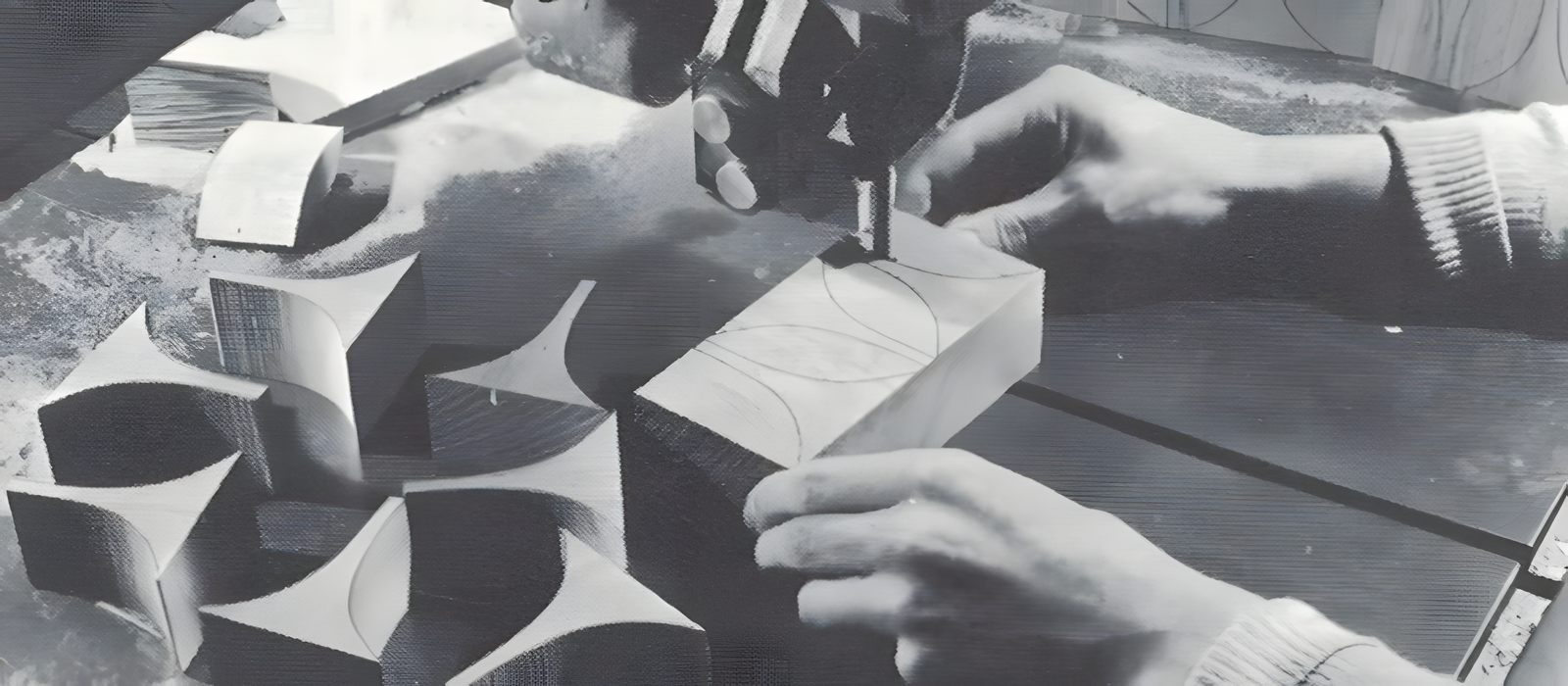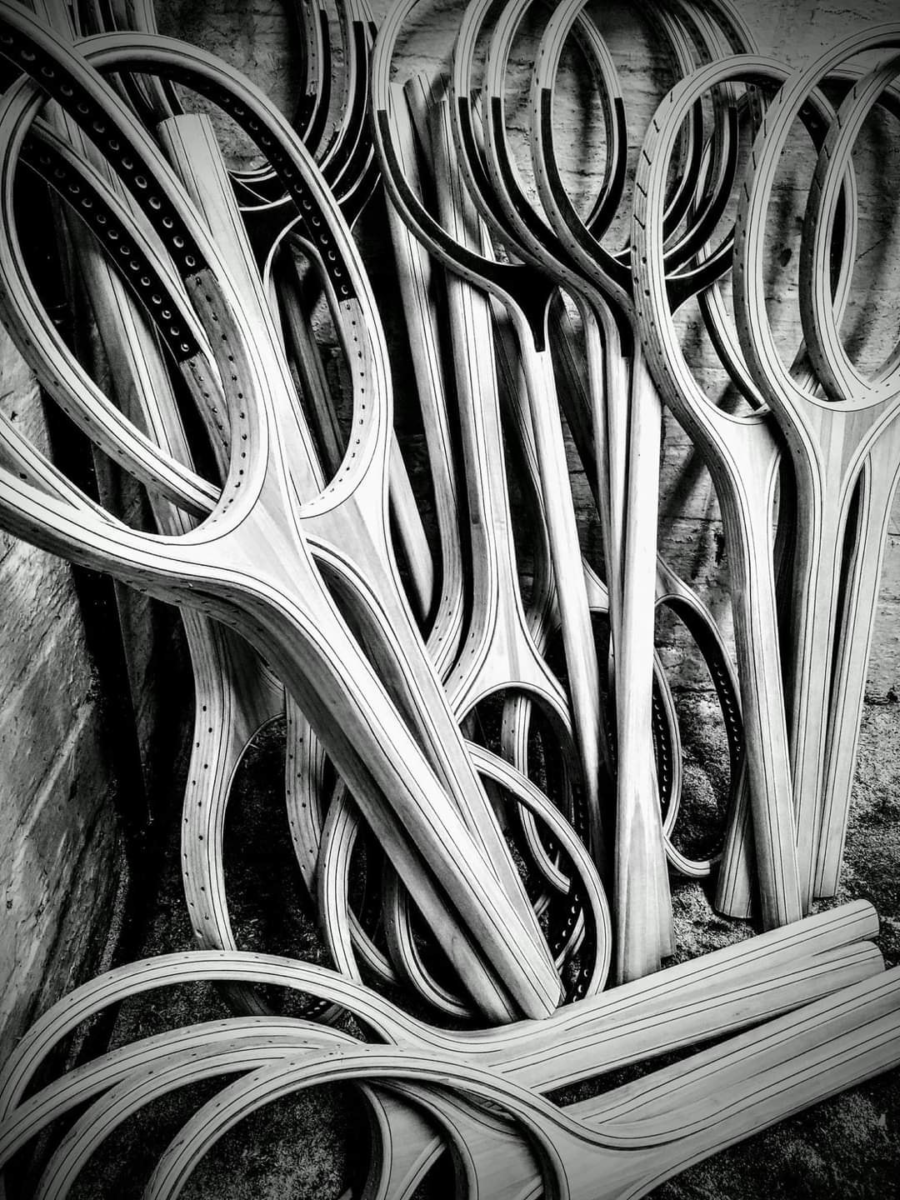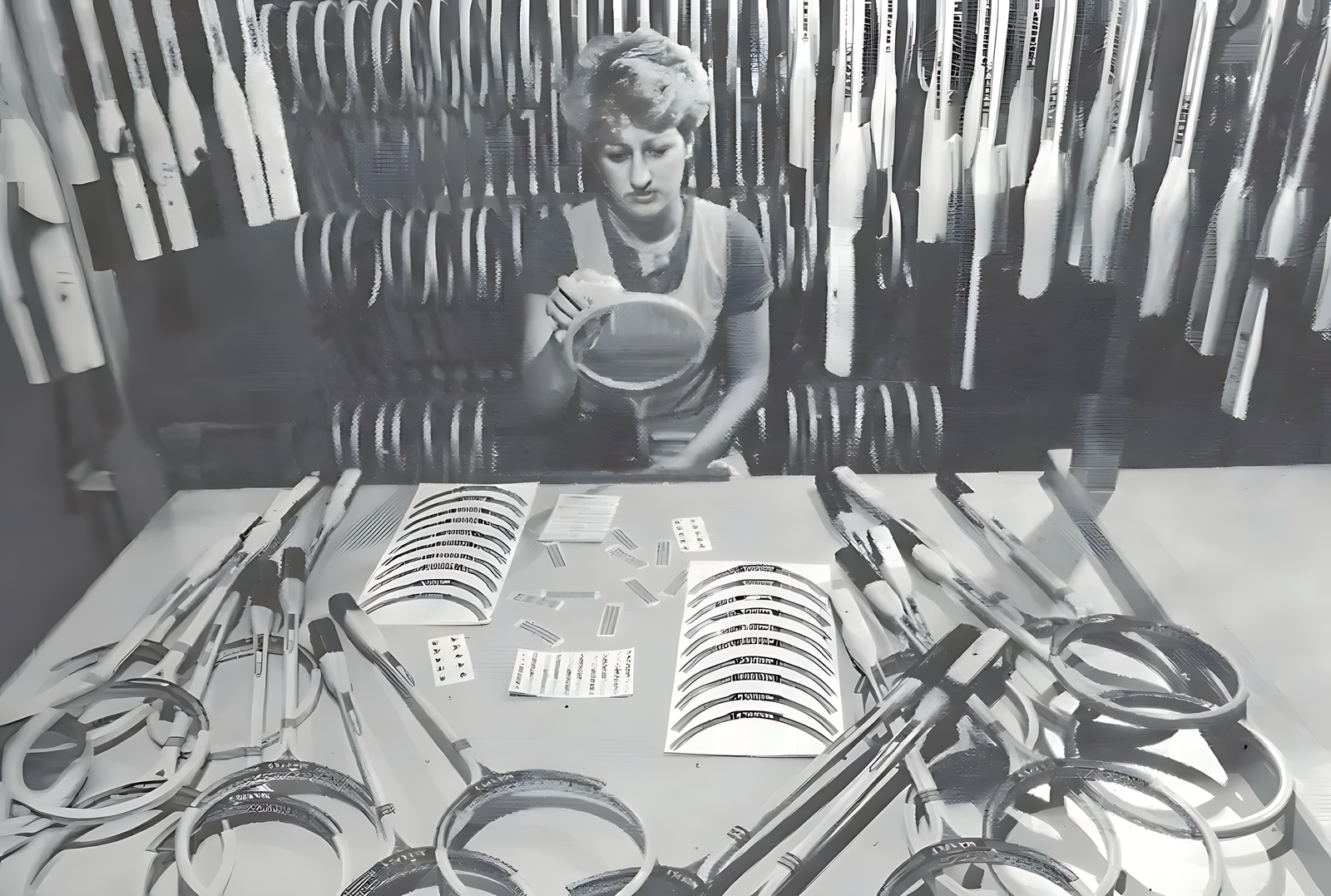Initially, rackets were made from a basic process, one simple piece of bent wood (usually ash) glued around a metal mold with animal glue. Frames were made of a single solid piece of ash wood, soaked in cold water, boiled to make it pliable and bent into the desired shape while still hot. One innovation was that the wood was not cut, but split and shaved along the grain, producing continuous fibre propagation along most of the racket frame, requiring careful selection of suitable wood specimens but improving the strength of the final specimen. Different types of woods might be used in different parts of the racket. Specifically, the wood used in the head might be different from the throat or shaft. Instead of using one piece of thick wood, each racket was made with strips, also called veneers, which were glued together. They were dried to very specific moisture levels in a kiln. They couldn’t be too dry, otherwise the glue wouldn’t work properly.
Historical Images:
Step-by-Step Process:
- Preparation: Wood is processed to a 10% moisture content for uniform stress.
- Cutting: Wood is cut into basic rectangular shapes considering the required dimensions.
- Shaping: The rectangles are cut into near-final shapes and further refined using abrasives like sandpaper.
- Lamination: Timber trunks are peeled into veneers, cut along the grain, and kiln-dried.
- Assembly: Laminated frames are constructed, with the grain following the frame’s curve to avoid weaknesses. Frames are bonded with synthetic resin glue and shaped under hydraulic pressure.
- Smoothing: Frames are cut, sanded
- Drilling: Holes are drilled into the frame for the strings, preparing it for string insertion
- Finishing Frame is painted, lacquered, and decorated with transfers.
- Stringing: Frames are strung with typically 18×20 tensioned mechanically for uniformity.
- Handle: end cap is added and stapled, and a leather grip is then applied with glue
Limitations of Wood
However there was a problem. At first these rackets were very weak in the throat area; so the next innovation in 1900 was to wrap combinations of canvas, vellum and bindings around the critical areas (throat and lower hoop). But then there was another problem namely warping of the frame when exposed to wet conditions. This was improved in 1910 with hickory and strips of metal reinforcement in the throat. Of course the wood was also very slippery in wet conditions so in 1910 players wrapped canvas around the handle and in 1920 Dunlop finally made the first rubber grips. The next advance was in the 1930’s, with the development of laminated frames consisting of an arrangement of the layers at different angles, hence achieving directional stiffness, the forerunner of carbon fibre lay-ups. Synthetic cements and formaldehyde were used to bond the odd layered frames, which consisted of sometimes eleven layers then as many as 20 layers.. Mechanization and chemicals in the 1940s allowed for more veneers bonded with urea-formaldehyde adhesives, leading to better consistency and ease of shaping. Various woods, including maple, sycamore, and hickory, provided desired properties like strength and wear resistance. Additionally more types of wood, like beech, were introduced as alternate layers with ash wood, resulting in a combination of the strengths of both materials (see below).
Racket manufacturers experimented with layers of wood, known as plies, to enhance racket construction. The idea of creating stronger wood by laminating different types of wood or materials dates back to the 12th century. Early rackets typically used a few layers, produced by bending steamed wood strips around a mold. the most famous of the wood laminates was the Dunlop Maxply. The racket was constructed from Vermont ash, cherry and hickory layers glued together with water-repellent glue. The handle plates were made of bass-wood and the entire racket was finished off by experienced craftsmen to produce a very elegant product. It was introduced in 1931 and used for almost 50 years, before being beaten off the shelf by more modern constructions made from lighter materials. Each Manufacturer experimented with different woods as follows:
Each Wood has its own properties.
Wood is a natural composite material, consisting of elongated cells distributed in its own natural resin. It is therefore anisotropic (i.e. much stiffer along the grain) and the composition of the structure is dependent on the type of tree and its growing conditions. These diverse properties are utilized in the
development of laminated frames, which could combine the strengths of the different grain directions and wood types. The harder woods, like birch, maple, mahogany, hickory and beech were used to stiffen rackets wile ash or maroti, a softer and more resilient woods, produced more flexible rackets and walnut, sycamore, maple, birch, cedar, mahogany and holly were used as the outer layer for their cosmetic appearance.
| Wood type | Specific gravity | Modulus of rupture (GPa) | Flexural modulus (GPa) | Shear strength (parallel to grain) (MPa) |
|---|---|---|---|---|
| Ash black | 0.49 | 0.087 | 11.0 | 10.8 |
| Ash white | 0.60 | 0.103 | 12.0 | 13.2 |
| Hickory pecan | 0.66 | 0.094 | 11.9 | 14.3 |
| Maple red | 0.54 | 0.092 | 11.3 | 12.8 |
| Oak, Red Willow | 0.69 | 0.100 | 13.1 | 11.4 |
| Sycamore | 0.49 | 0.069 | 9.8 | 10.1 |
| Cedar Incense | 0.37 | 0.055 | 7.2 | 6.1 |
| Beech | 0.64 | 0.103 | 11.9 | 13.9 |
| Birch yellow | 0.62 | 0.114 | 13.9 | 13.0 |
| Walnut black | 0.55 | 0.101 | 11.6 | 9.4 |
Wood Inserts
Starting around 1950 manufacturers who wanted to improve on the mechanical properties of wooden laminates figured out that they could add a layer of leather between wood laminates. This had a very small effect, improving resiliance more than strength. So they began to experiement with metals, polyamides and finally composites like glassfibre and graphite until the percentage of wood disappeared and was replaced completely by composite frames, thus ending the legendary wooden era. The introduction of a single leather laminate allowed more geometric freedom and increased strength but was soon replaced in the 1960’s with Black Walnut, Vulcan fibre (a resin impregnated in paper) or even new plastics, like Bakelite. During the 70s glass and graphite fibre laminations were also introduced, increasing frame strength even more. Composites of glassfibre in epoxy paved the way for what was probably the greatest revolution in tennis rackets to date. Initially glass fibres were mixed with carbon fibres but later evolved in rackets with carbon fibres as the main component. Eventually these composites were so strong, they could be made from a hollow cyclinder. For equal diameter, a solid tube will have a higher bending stiffness, bending strength, and resistance to buckling but for equal weight the reverse is true and the hollow tube will win. So rackets became hollow, (lately filled with foam) and the carbon fibres made it possible to obtain stiffer, lighter and longer lasting rackets. From 1980 till the mid 1990’s polyamide was also used in frames, either as a thermoplastic injection with carbon fibre reinforcements, or as braided filaments combined with graphite fibres. Here some info on additives:
Graphite Fibres
Graphite used in racket frames is not the true graphite you would find in a pencil, but a carbon fiber that adds stiffness and strength to the plastic epoxy resin resin with which it is mixed to form a frame. Even 100% graphite frame is at least 40% resin. So graphite is early form of carbon fibre mixed with epoxy resins. a lightweight material and its properties provide strength, stiffness, and good vibration absorption. Graphite’s downside is it can be brittle and expensive. Graphite’s flexible and less dense nature allow it to transmit more energy directly to the ball while its lightweight frame reduces vibrations caused by hitting it against an object such as steel would do.
Carbon fibres
Carbon fiber is a lightweight, high-strength material composed of carbon atoms. It is known for its excellent strength-to-weight ratio and stiffness. The raw material for carbon fibres is a fibre made out of Polyacrylnitril (PAN). The precursor, consisting of 12000 filaments, is commonly used in rackets after undergoing heat and stress treatment. This process, known as pyrolysis, predominantly determines the properties of the final fibre. Heat treatment at between 1000°C and 2400°C causes oxidation and dehydrogenation, producing fibres like; high strength (HST), high modulus (HM).
Glass fibres
Glass fibres were the first fibres used as reinforcement in rackets. Fibres consist mainly of silicium oxide and are spun from molten glass. The most important type of glass is a so called E-glass, with the “E” representing electric, due to its original used in electrical applications. Compared to carbon the advantages and disadvantages are easy to distinguish; it exhibits high tensile stress but low stiffness and high compression stress combined with a higher density.
Boron fibres
The Prince Boron tennis racket was one of the first applications for boron. Boron fiber / boron filament, an amorphous element of B5 by-product, representing a primary industrial usage of elemental (free) boron. Boron fibers are 100-200mm in diameter with a tensile strength between 3-4 GPa, and Young’s modulus ranges from 380 to 400 GPa. Boron is lighter than carbon (the main constituent of graphite), so it was used in graphite composition to make the frame lighter (e.g., compared to a 100% graphite frame) but to make it stiffer (being denser for the same amount of material in a layup). Boron transmits vibrations better than graphite because it is lighter and stiffer. Frames made of boron are very durable.
| Material | Young’s modulus E in GPa | Density ρ in mg/m3 | √E /ρ | Strength in megapascals (1MPa=1 million Pa) |
|---|---|---|---|---|
| Composite | 90 | 2.0 | 4.7 | 500 |
| Steel | 210 | 7.8 | 1.9 | 400 |
| Aluminium | 71 | 2.7 | 3.1 | 300 |
| Wood (Ash) | 10 | 0.5 | 6.3 | 50 |
| Boron | 400 | 2.4 | 3000 |
Historical Images:
Citation: Materials and Tennis: Rackets by H. Lammer & J. Kotze HEAD SPORT AG 29 June 2004 | https://bettersquash.com/2022/20220923#:~:text=Instead%20of%20using%20one%20piece,glue%20wouldn’t%20work%20properly.




